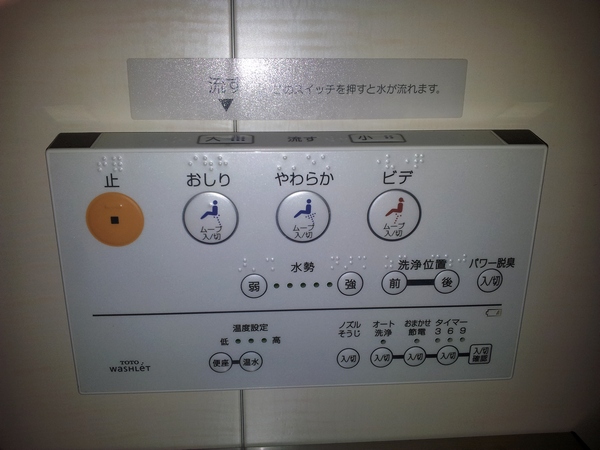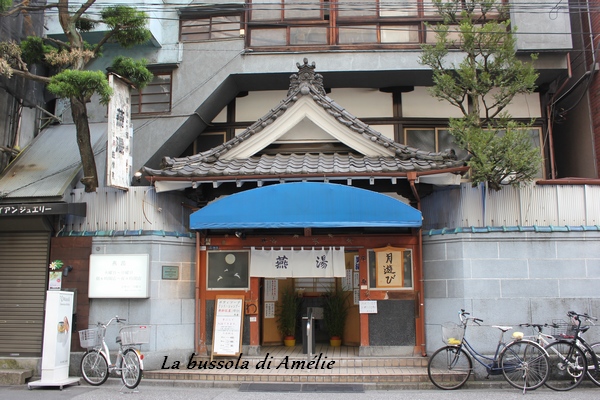-
The Japanese toilet. Going to a Japanese bath is a unique experience that you will never forget. Again, these people and this country will surprise you. Toiletries in Japan play an important role in the culture of this country where cleanliness and hygiene are the top priority, and this is why the toilets are very different from those we use in the West. Even in the bathrooms, the Japanese are turning to technology, and yet the appearance is similar to a simple water here instead it is actually a washet, a water of many options that can be accessed through a control panel placed next to the palette or On the wall next door.
 There are several options, but the most widespread one is no doubt the integrated bidet, which is possible thanks to a tube that comes out from beneath the aisle emitting a jet of hot water for intimate hygiene. There are generally two cleaning modes depending on the intimate part you want to clean and it’s nice to see the figures on the keys for the different options. Some people to whom I have told these things have looked at skeptical faces due mostly to personal ignorance, but I want to point out that at no time the tubular touches the body of the user and after and before use self-polishes. So both the type of cleaning and the type of jet is decided by the user through that control panel.
There are several options, but the most widespread one is no doubt the integrated bidet, which is possible thanks to a tube that comes out from beneath the aisle emitting a jet of hot water for intimate hygiene. There are generally two cleaning modes depending on the intimate part you want to clean and it’s nice to see the figures on the keys for the different options. Some people to whom I have told these things have looked at skeptical faces due mostly to personal ignorance, but I want to point out that at no time the tubular touches the body of the user and after and before use self-polishes. So both the type of cleaning and the type of jet is decided by the user through that control panel.When I first entered a Japanese toilet I acted for everything and everything like a baby girl on the first day of school. I sat on a palette, benefiting from the heat of the latter immediately, and I started pressing a set of keys moved by an irrepressible curiosity without asking me exactly what those designs meant and so I tried any kind of option laughing like a stupid in Bathroom, and of course when I saw a button with two music notes I decided to crush it too and I started to hear music with the sounds of the forest, very delicate: yes yes, since the Japanese are very tedious and reserved, there is the ability to turn on music to avoid to make embarrassing noises from your bathroom. The most absurd thing is that I did not know how to draw the flush since the writing was in Japanese and so I started looking at the control panel thinking about the options that were already used that were to be discarded and finally after a few minutes I realized what I had to do!
After that episode, I noticed that in fact in some bathrooms the flush button is indicated with an arrow so it is plausible to think I’m not the only one to have this problem!
-
Women’s baths. They are equipped with storage space and where to take care of the toilet, Japanese women are very focused on the beauty of their body and in this case their face and so it is not uncommon while we are drying our hands looking at women with already perfect skin Apply cosmetics of various kinds and check that the makeup is still perfect.
-
The bathroom in the Japanese houses and the art of the Furo. This aspect has always intrigued me for several reasons: first because it had been discussed by superiors and the university. From my superiors, I began to study anthropogenic geography, a matter that I then continued to study, and so the study of the peoples of the world, their landscapes and above all their cultures has always fascinated me and interested me. It struck us in the West that the whole family was washed with the same water because when it came to the water there had already been clean, so I wanted to better understand this aspect.
Second, part of my interest was due to the idea that we do after seeing Japanese manga/ anime (I’m talking about introducing it to Japan). In all Japanese homes, the bathroom conceived as we know it does not exist. Apart from the separation of the toilet from the rest of the bath, which exists in other countries, in the land of the Sol Levante, there is a tub that can be covered with a bellows cover that will serve to keep the water temperature warm but what Even more important, is the bathroom drainage system because you will bathe out of the tub! This practice foresees that we sit on a stool and wash well with the help of a small towel used as a sponge and rinse with a hot water cart. Only once you get clean and washed for good you will dive into the hot water because that same water will be used by the other family members.
-
Public Baths (Sentō) and Normal Sources (Onsen).

-
After a terrible night at a Tokyo Net Café, we decided to relax and refresh ourselves in a typical Tokyo public bath (Tsubame-yu).
Since I started telling my family and friends about my departure for Japan, the places I would have seen, the things I would do, when talking about Onsen or public baths I repeated that it would be too embarrassing and the Everything ended with a big laugh. It has to be said that I had imagined places where men and women found themselves in the same place and the reason for the embarrassment was obviously generated by that thought.
My boyfriend had already reassured me that public baths and Onsen are divided between men and women unless a couple decides to book a private Onsen.
Me and my boyfriend came in together, but we immediately split up to go everywhere in our area. So suddenly I found myself alone in the midst of Japanese women and girls… naked or stripping. I did not even know where to start, and it seemed to me that they all used the same type of towel. Can you imagine how awkward the situation is and how disarming you can not ask the owner if I could use my towel ?!
I was the only western and I did not speak a Japanese word, and fortunately the lady had seen that I had come in with a Japanese she used it by the way (the public baths for women and those for men are divided by only one wall of wood): there was no particular towel to use, so I had to do nothing but strip off and go to the sink and bathtub area. I had imagined that moment for a long time, I had imagined my embarrassment to bare naked in front of people never seen, but everything was natural, indeed I must say I was more curious than I was because I was so different. It was a great experience and it seemed to me once again to be in a typical Japanese anime and before to live that place the owner gave me a towel as a souvenir!!
- But how does a Sentō works and in which way is different from Onsen? Onsen, unlike public baths, can also be outdoors and the water of the pools is a mineral-rich spa, it’s a bit like our spas, obviously in a different architectural and landscape setting. There are many places that have become famous for the presence of these thermal waters where travelers/tourists, as well as the Japanese themselves, go to enjoy these waters.
The public bathrooms, however, have taps and a unique bath where the bathers can dive and relax. The purpose of the public bath is only to clean it and that’s why shampoo and bath foam are also available.
When you enter one of these structures, the first thing you do is to take off your shoes as usual, but immediately afterward you bury yourself by putting all your personal belongings in the cabinet you are assigned to or just being free. You will have to keep a towel that will serve you later to dry, and if you do not want to use the supplied products, carry with you the need that you usually use for showering. This is the dressing area and from here you will have to enter the actual area of baths or onsen. In the case of public baths, as mentioned shortly, the tanks will be in the same area, in the case of the onsen the washing area could be found inside while the spa tubs are inside but above the outside.
The washing area consists of taps with hot and cold water with stools nearby and where you will have to sit for washing. You wash it thoroughly, and after you have it you cigare just as well, because you have to enter the tanks without any trace of soap! To get rid of a pool of water and throw it over the body, you should repeat this operation several times to avoid leaving any residues.
After entering the tubs if it is an onsen, you can move from one tank to another depending on your preference. Or in the case of public baths, you can stay silent in the same tub as you want, but considering that temperatures are usually very high, you probably will only have ten minutes. At the end, you can rinse the faucets or return to the dressing area after drying up with your towel and dressing, drying your hair, and occasionally dedicate yourself to the makeup without leaving any spaces. As for the phon in some public bathrooms, you will have to pay a small sum, if I do not erase 20 yen for 10 minutes, to activate the phon.